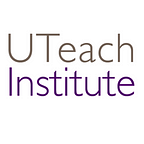UTeach’s First 25 Years: Preparing Teachers Is a Mission
by Michael Marder, Executive Director of UTeach, The University of Texas at Austin
In the fall of 1997, 25 years ago, UTeach began at The University of Texas at Austin. It began in response to shortages of teachers in math and science. Despite these shortages, which made it difficult for schools to offer basic subjects like calculus and physics, and although UT Austin was one of the largest universities in the United States, UT was preparing only a few dozen math and science teachers a year.
UTeach began by bringing together award-winning former secondary math and science teachers (called Master Teachers), science and mathematics education faculty, and science and mathematics researchers to design a way for undergraduate students to get both their major degree and teaching certification in four years. The first steps were for students actually to teach carefully supervised lessons in elementary and middle schools. If they found that teaching ignited a spark in them, they continued with additional coursework and fieldwork, culminating in a bachelor’s degree in science or mathematics and a teaching certificate.
When students were prepared to teach through this pathway, they were very likely to enter teaching: 90% of them did so. And they were likely to stay: 80% of those who entered teaching taught at least five years. The numbers of students pursuing the teaching path more than doubled in comparison with the years before UTeach. They were strong students with the same high grade point averages as other students in the College of Natural Sciences, and more of them came from underrepresented groups than was typical in the College.
Based on these results, UTeach became a national model and in 2006 began to spread to other universities. Today, UTeach is in 13 universities in Texas, and 50 across the United States.
It would be wonderful to say that UTeach has solved the science and mathematics teacher shortage problem in the United States. UTeach programs have increased the numbers of teachers they prepare and contribute more math and science teachers every year. Unfortunately, over the last decade, the total number of science and mathematics teachers prepared across the country has been dropping. While U.S. universities prepared around 24,000 science and mathematics teachers in 2010–2011, by 2018–2019 the number had fallen to under 14,000.
The shortage of science and mathematics teachers has never gone away, and students who grow up facing the greatest disadvantages pay the largest price. Around 30% of Black students attend high schools that do not offer physics at all. Such problems caused by teacher shortages have been so severe for so long that they attract little notice. Now in the wake of the pandemic, teachers are retiring early and resigning in such numbers that shortages are beginning to affect students from every community. This needs to become a moment of renewed attention to preparing teachers, and to supporting their success in their critical first three years and beyond.
It could instead be a time when we let standards for preparing teachers drop. Texas prepares by far more teachers through alternative certification programs than any other state. Most of them come through web-based for-profit programs, and it is possible for teachers on these pathways to enter teaching without having practiced and prepared. In fact, teachers from alternative pathways have outnumbered those from standard pathways in Texas since 2015, and the companies that make this possible are expanding to other states.
Alternative certification has an important role to play in responding to shortages and providing fast and inexpensive routes into teaching. However, this ability to respond to crises becomes a problem if it crowds out the standard university-based routes into teaching. When Texas elementary and high school students are taught by university-certified teachers, they learn more than those taught by alternatively certified teachers — on average one to two more months of learning across the academic year. This holds true across all grade levels and all subjects, and over all university teacher preparation programs. For high school science and mathematics students taught in particular by UTeach graduates, the learning gains are even greater: four to six months of extra learning.
The next 25
As UTeach enters its next 25 years, and as it prepares to expand to the next 50 universities, the task at hand is more important than ever. UTeach began with great ideas from a small, committed group at one university. Now UTeach represents the communal knowledge and collective energy of thousands of aspiring teachers and faculty across the United States.
With U.S. university teacher production in decline, and the pressure to adopt inexpensive web-based solutions growing, UTeach has an essential role to play. The challenge is to remind public universities that preparing teachers was part of their founding mission, and that this mission is not complete until marginalized students in every community have the teachers they need to take advantage of the opportunities America can offer.
If UTeach is successful, there will be a resurgence in teachers prepared at universities, in the support practicing teachers get from universities, and in the innovation coming from students across the whole United States who have the chance they deserve to learn mathematics and science. This will be the goal of UTeach in its next 25 years.
